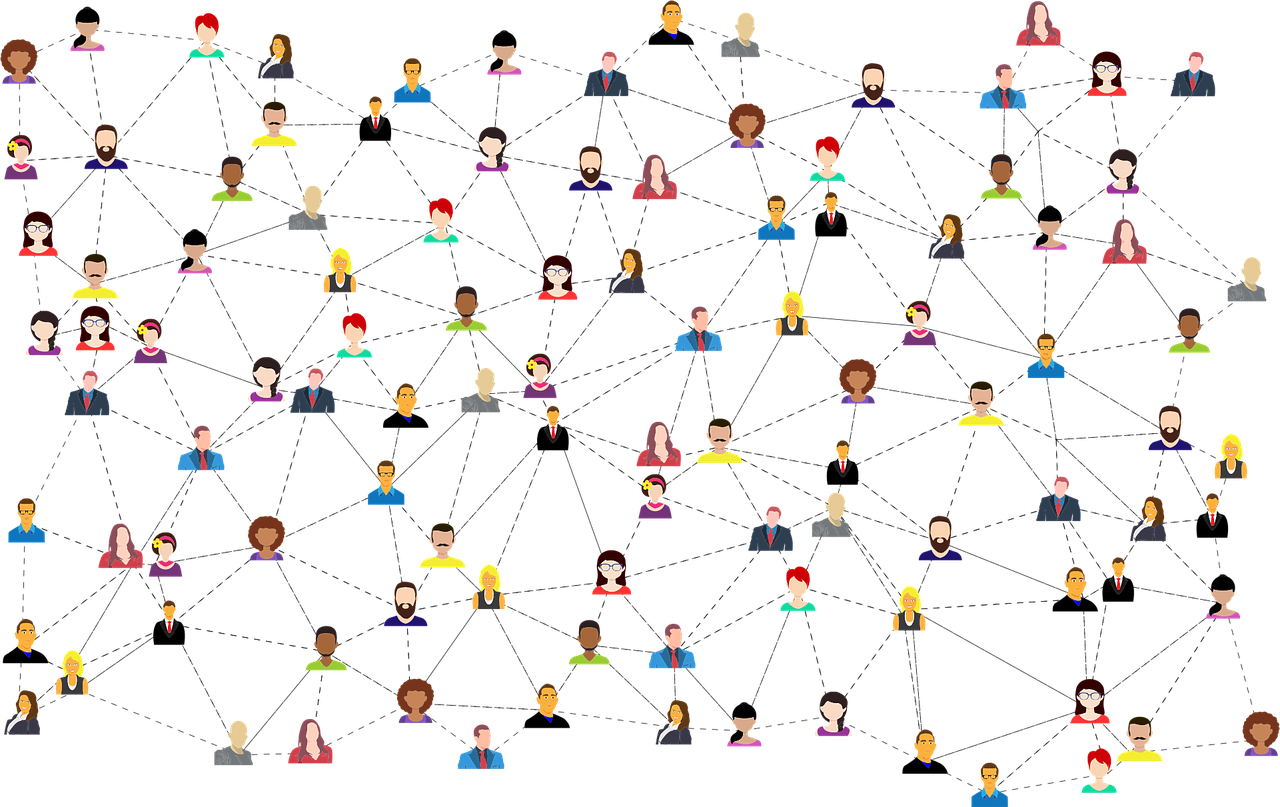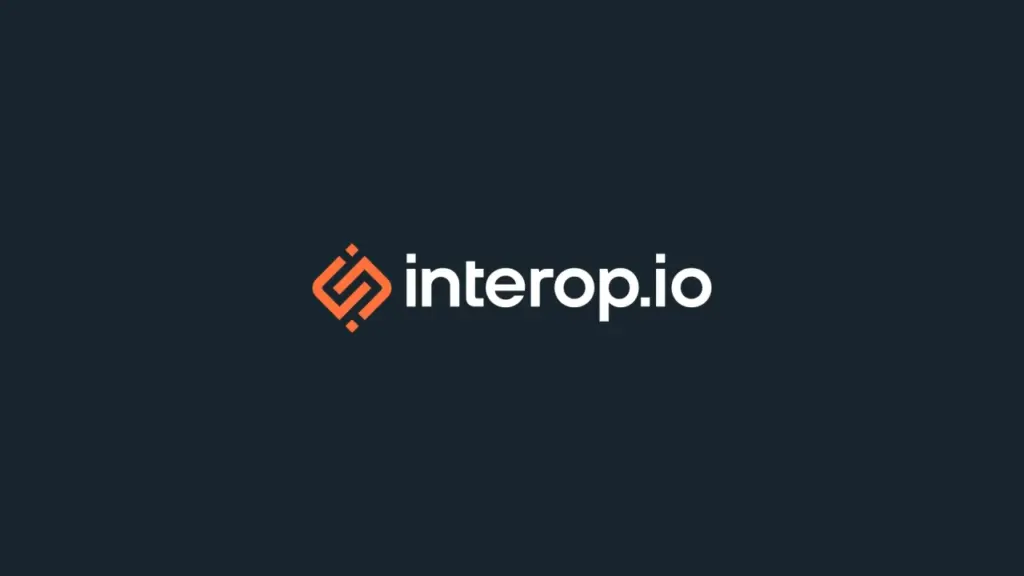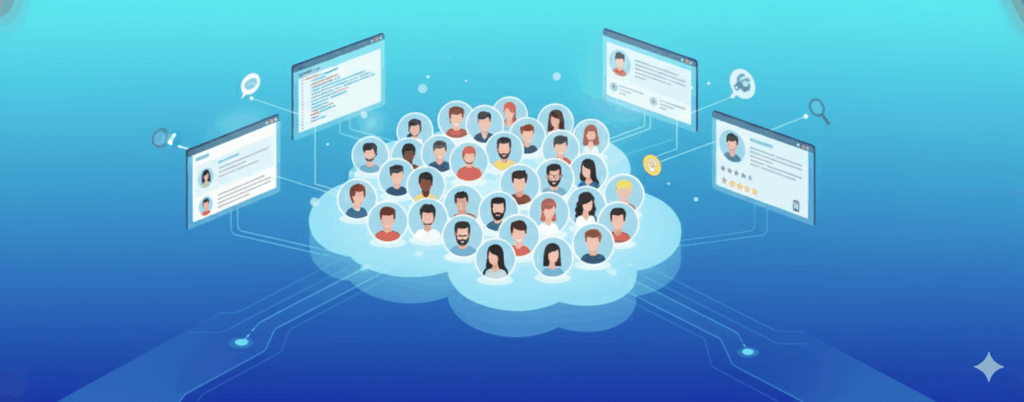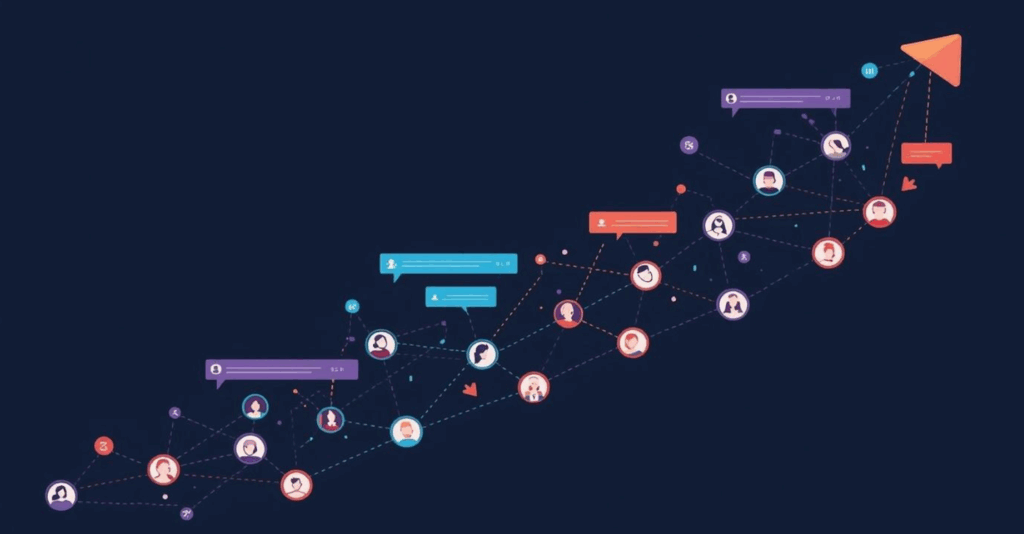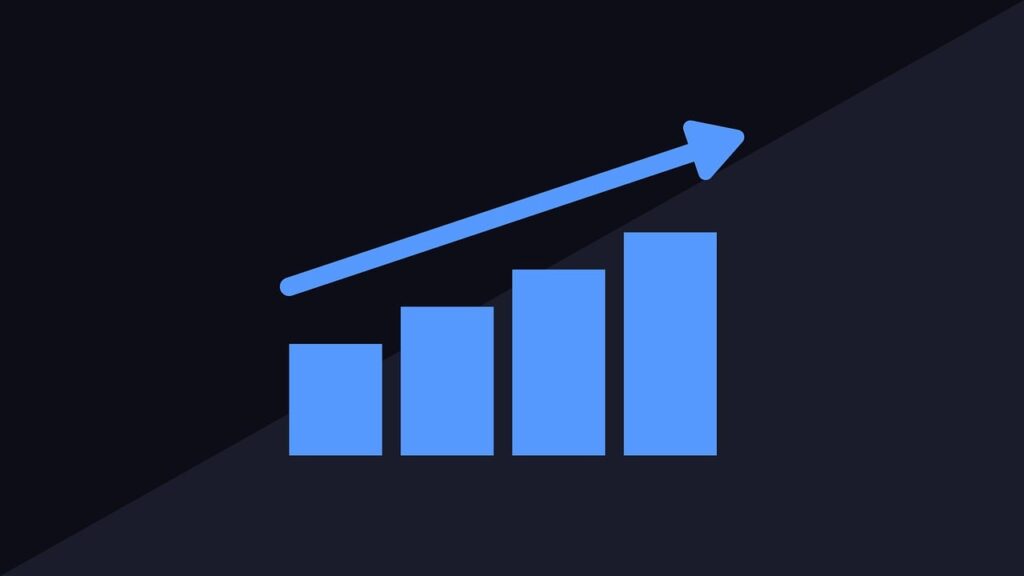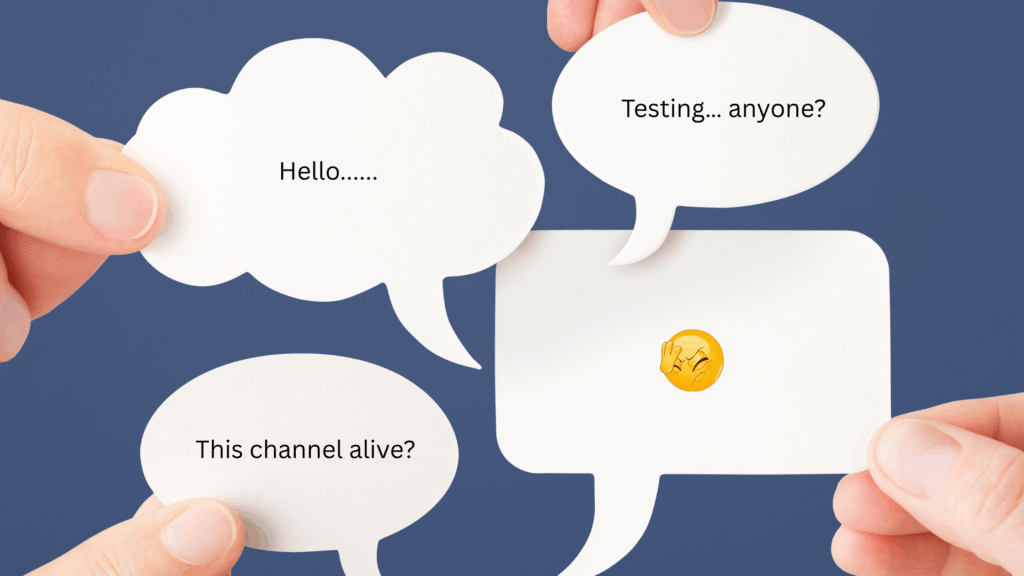Check your community analytics from last month. Now count how many members actually did something.
The gap between those two numbers is the participation problem, and it’s costing you more than you think.
Low participation means your community infrastructure is missing critical systems. The members are there. The platform works. But the bridge between joining and contributing is broken.
At Stateshift, we’ve worked with 240+ tech companies to solve exactly this challenge. Whether you’re running a Discord server, Slack community, or forum, the participation gap appears regardless of company stage, platform choice, or team size. Tech communities that thrive have repeatable systems that convert interest into action.
Why Most Communities Struggle With Participation
Teams typically set up infrastructure and hope engagement follows naturally. Platform launches happen. Welcome messages get posted. Channels get organized. Then participation flatlines.
We’ve worked with tech companies at every stage, from early-stage startups to Fortune 500s. The participation gap always traces back to missing systems that guide people from curiosity to contribution.
Your community platform provides the space. Systems provide the path. Without clear systems that move people from entrance to meaningful activity, they wander, get confused, and leave. The path to contribution needs to be visible and structured.
The Participation Funnel: Where Teams Actually Lose Users
Before you can fix participation, you need to diagnose where people are getting stuck. Most communities lose potential contributors at three critical points.
The Join Gap
Someone discovers your community but can’t determine what value they’ll get from joining. The proposition feels vague or unclear.
The First Action Gap
They join but have no clear next step. What should they do first? Where do beginners fit in? The cognitive load of figuring this out becomes too high, so they do nothing.
The Repeat Action Gap
They participate once but never return. Nothing brings them back. No feedback loop. No recognition. No progression.
Most teams focus exclusively on getting people to join. They pour energy into marketing and announcements while the systems that convert members into contributors get ignored. Participation stays flat even as membership numbers grow.
10 Signs Your Community Needs Better Participation Systems
Not sure if your participation problem is systemic? Here are the warning signs:
| 1 |
More than 70% of members have never posted or contributed
This indicates a broken first action system
|
| 2 |
New members ask “where should I start?” frequently
Your onboarding lacks clarity
|
| 3 |
Engagement spikes only when you post, then goes silent
Missing rituals and member-to-member loops
|
| 4 |
The same 5-10 people answer every question
No contribution paths for mid-level members
|
| 5 |
Event registrations are high but attendance is low
Format mismatch or value proposition unclear
|
| 6 |
Contributors don’t return after their first contribution
Broken feedback loop
|
| 7 |
Your team manually prompts every conversation
No systematic engagement triggers
|
| 8 |
You can’t explain what “success” looks like for a member
Undefined progression paths
|
| 9 |
Most contributions are questions, very few are answers
Imbalanced value exchange
|
| 10 |
You’re tracking member count instead of active contributors
Wrong metrics focus
|
If you’re seeing 3 or more of these patterns, your community needs systematic fixes, not more promotional effort.
The Stateshift Framework for Community Participation
Through our work helping companies increase user participation in tech communities, we’ve developed a framework that consistently drives engagement without adding team burden. These are repeatable systems, tested across different platforms and company stages.
The framework has five interconnected systems. Each one addresses a specific friction point in the participation funnel.
1. Clarify the First Win
Every new community member should know exactly what their first valuable action looks like. Frame it around what they gain, not what the community needs from them.
Instead of “Introduce yourself in the welcome channel,” try “Share one technical challenge you’re working on this week and get feedback from the community.” The second version creates immediate value.
This is where gamification starts to matter. Clear progression shows members the value exchange. When someone can see “I did X and got Y outcome,” they understand why participation matters. That clarity drives repeat engagement.
We’ve seen communities double first-week engagement just by redesigning their onboarding prompt to focus on user benefit rather than community logistics.
2. Design Simple Rituals
Participation thrives on rhythm. Weekly ask-me-anything threads. Monthly challenges. Recurring office hours. These rituals create predictable moments when people know engagement is happening.
The key is making rituals simple to join. If participating requires reading three context documents and scheduling a meeting, you’ve already lost people. The best rituals have a single, clear entry point that takes less than five minutes.
Live and virtual events work particularly well as recurring rituals. Real-time interactions create stronger connections than asynchronous threads alone. When people can ask questions, share experiences, and get immediate responses, they feel heard rather than marketed to.
The format matters less than the accessibility. Organizations now blend virtual, hybrid, and in-person formats based on what their communities actually need rather than defaulting to one approach. This flexibility reflects a broader shift: communities want formats that fit their schedules while still creating meaningful engagement.
Live streams, AMAs, and interactive workshops provide something asynchronous content can’t: real-time feedback and dynamic conversation. You learn what your community actually needs in the moment, not three days later when the thread has gone cold.
One client we worked with implemented “Tuesday Wins” where community members share one success from the past week. Participation in that single thread now generates more engagement than everything else combined. The barrier to entry is minimal and the reward (recognition) is immediate.
3. Recognize Contributions Systematically
Most community managers recognize top contributors manually, whenever they remember to do it. That approach doesn’t scale and creates inconsistent signals about what matters.
Systematic recognition means every contribution gets acknowledged through a predictable process. This is where gamification shows real impact through visible progression and meaningful recognition.
Set up automated systems that highlight first-time contributors. Create contribution ladders that show members how to increase their impact. Publicly recognize specific contributions in ways that tie back to business outcomes.
When a community member knows their effort will be seen and valued, participation becomes its own reward. Recognition doesn’t need to be elaborate. Consistency matters more than complexity, and the recognition needs to reinforce the actions you want to encourage.
4. Build Clear Contribution Paths
Participation stalls when people hit the “what’s next” wall. They’ve done the beginner activities. Now what?
Design explicit progression paths that move people from passive consumers to active contributors to community leaders. Each stage should have clear criteria and visible next steps.
For example:
- New Member: Complete your profile, introduce yourself, ask your first question
- Active Member: Answer three questions, share a resource, attend an event
- Contributor: Host a discussion, create a tutorial, help onboard new members
- Leader: Mentor others, suggest improvements, represent the community externally
This framework reduces decision fatigue. When people know what valuable actions they can take next, they’re more likely to take them.
Gamification works here through visible milestones and unlocked capabilities. As members progress, they gain access to new channels, opportunities, or recognition levels. This progression creates natural engagement momentum without feeling forced or arbitrary.
5. Close the Feedback Loop
Participation dies in silence. When someone contributes and hears nothing back, they won’t contribute again.
The feedback loop has three parts: acknowledgment (we saw your contribution), impact (here’s what happened because of it), and invitation (here’s the next opportunity).
Closing feedback loops doesn’t require massive team resources. Systems handle most of the work. Automated acknowledgments for first contributions. Weekly roundups showing how member input shaped product decisions. Regular highlights of community-driven wins.
One company we advised implemented a simple change: whenever an engineer solved a problem using community advice, they posted back in the original thread. That single practice increased response rates by 40% because members could see their help created real value.
Quick Reference: Participation System Implementation Guide
Here’s how to implement each system based on your community’s current state:
| System | Starting Fresh | Low Engagement | Growing |
|---|---|---|---|
| First Win | Create one specific first action with immediate value | Track where members drop off in first week | A/B test prompts for completion |
| Rituals | Launch one weekly event (same time/format) | Double down on events with repeat attendance | Add ritual to fill event gaps |
| Recognition | Automate welcome for first contributors | Weekly highlight thread for contributions | Tiered recognition system |
| Paths | Define 3-4 levels with clear criteria | Map what active members did first | Create role-based progression |
| Feedback | Acknowledge all contributions in 24hrs | Show how input influenced decisions | Invite contributors to beta programs |
Move From Vanity Metrics to Meaningful KPIs
Most teams track metrics that feel good but mean nothing. Total members. Message volume. Event registrations.
These numbers make nice charts, but they don’t tell you if your community is healthy. You need metrics that connect participation to business outcomes.
Track these instead:
First Action Completion Rate: What percentage of new members take their first meaningful action within seven days?
Repeat Participation Rate: How many members contribute at least twice per month?
Contributor Progression: How many members move from passive to active to leading roles?
Impact Attribution: How often does community activity directly influence product adoption, support deflection, or feature development?
Developer Influence Hours: The cumulative time developers spend engaging with your brand. Every minute a developer reads your blog post, attends your event, watches your video, or participates in your community counts as influence hours. It’s a framework we developed at Stateshift to measure actual attention earned, not just activities counted.
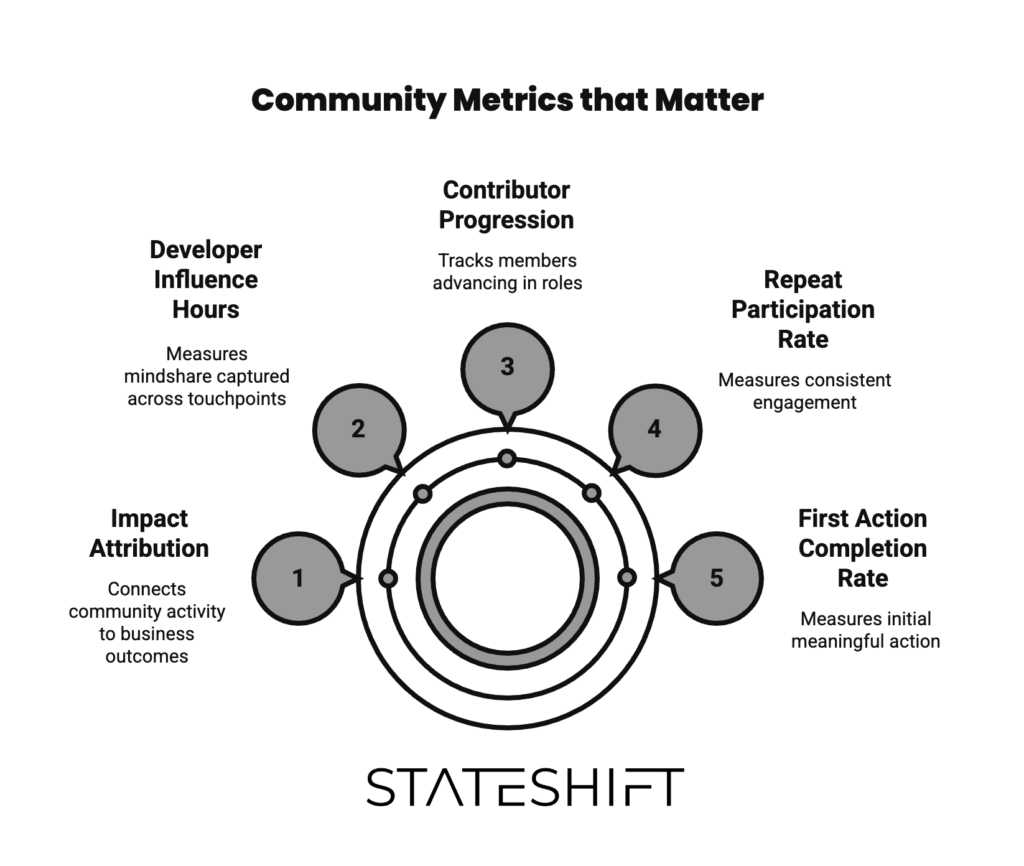
When you track first action completion and repeat participation, you’re measuring if your systems work. When you track contributor progression, you’re measuring if people are advancing. When you track impact attribution, you’re connecting community to business outcomes. And when you track Developer Influence Hours, you’re quantifying the total mindshare you’ve captured across every touchpoint.
Traditional metrics count how many people showed up. These metrics measure whether participation is actually driving value.
Real Community Turnaround: From 100 Members to Systematic Growth
We recently worked with a dev tools company facing the classic participation problem. They had 100 members in their Discord. About five were active. The rest lurked or had stopped showing up entirely.
The diagnosis was straightforward. No clear first action. No recurring rituals. No recognition system. No progression paths.
We implemented the Stateshift framework over eight weeks:
Week 1-2: Redesigned onboarding to focus on first win (share your integration challenge and get feedback)
Week 3-4: Launched two simple rituals (Tuesday Wins and Thursday Tech Questions)
Week 5-6: Built automated recognition for first-time contributors and established contribution ladders
Week 7-8: Created visible progression paths and closed feedback loops with impact highlights
Results after 90 days: first action completion jumped from 8% to 34%. Repeat participation increased from 5% to 22%. The community effectively ran itself with minimal team intervention because the systems handled most of the work.
This outcome came from systematic design, not luck or charisma.
Gamification That Works (And What to Avoid)
Gamification gets a bad reputation because most teams implement it badly. Slapping badges on random activities doesn’t drive participation. It creates noise.
Effective gamification does three things:
Makes Progress Visible
Members can see how far they’ve come and what’s next. This reduces uncertainty about where they fit and what they should do.
Creates Meaningful Milestones
Recognition tied to actions that matter to your business. First question answered. First tutorial created. First community event attended.
Enables Progression
As members contribute more, they unlock real capabilities or recognition. Access to exclusive channels. Opportunities to shape product direction. Public acknowledgment as subject matter experts.
What doesn’t work: arbitrary points systems, complicated achievement trees, or gamification that feels disconnected from actual value creation.
The best gamification feels natural. The community recognizes and rewards the behavior it values most without creating artificial game mechanics.
Building This Without Burning Out Your Team
Every framework we’ve described is designed around a single principle: systematic design reduces team burden.
When you build participation systems instead of relying on constant manual effort, community management becomes sustainable. Your team isn’t firefighting low engagement every week. They’re maintaining systems that generate engagement automatically.
Start with one system. Get it working. Then add the next. This is how we approach community growth at Stateshift: incremental, measured progress toward systematic participation.
The teams that succeed treat community building like product building. You wouldn’t ship a product without onboarding flows, activation metrics, or retention systems. Your community deserves the same systematic approach.
Your Next Steps: From Theory to Implementation
Pick one friction point in your participation funnel. Just one.
Is it the first action gap? Design a clearer first win this week. Make it valuable for members and easy to complete.
Is it repeat participation? Launch one simple ritual next Tuesday. See who shows up. Iterate based on what you learn.
Is it recognition? Set up automated acknowledgment for first-time contributors. It can be as simple as an automated welcome message or a weekly highlight thread.
When people search for how to increase user participation in tech communities, they typically find scattered tactics. What you need are integrated systems that work together. That’s what we build at Stateshift.
If your community feels stuck, you don’t need more effort. You need better frameworks.
Frequently Asked Questions
How do you increase user participation in tech communities?
Build systems instead of hoping for organic growth. At Stateshift, we’ve identified five core systems through our work with 240+ tech companies: clarify the first win (make the first valuable action obvious), design simple rituals (create predictable engagement moments), recognize contributions systematically (automate acknowledgment), build clear contribution paths (show members how to progress), and close feedback loops (show impact of contributions). Most communities fail because they have platforms but lack these underlying systems.
How do I measure if user participation is increasing in my tech community?
Track first action completion rate (percentage taking meaningful action within 7 days), repeat participation rate (members contributing 2+ times monthly), contributor progression (movement from passive to active roles), and impact attribution (how often community activity influences product adoption or support deflection). At Stateshift, we use a concept called “Developer Influence Hours” to measure real community impact rather than vanity metrics like total members or message volume.
How long does it take to see participation increase after implementing these systems?
With systematic changes, you should see measurable improvement within 30 days. First action completion rates typically improve within two weeks of clarifying the first win. Repeat participation takes 4-6 weeks to shift as rituals establish rhythm and members experience the value of returning.
What are common mistakes that prevent user participation in tech communities?
The biggest mistake is focusing on getting people to join while ignoring the systems that convert members into contributors. Through our work helping companies increase user participation in tech communities, we’ve seen these critical mistakes repeatedly: no clear first action (new members don’t know what to do), inconsistent or missing rituals (no reason to return), manual recognition (doesn’t scale), undefined progression paths (people hit the “what’s next” wall), and broken feedback loops (contributions die in silence). These aren’t personality problems—they’re system problems that require systematic fixes.
Ready to turn your community into a systematic growth engine? Stateshift helps tech companies build frameworks and systems that drive participation without burning out teams. Let’s talk about your community challenges.


